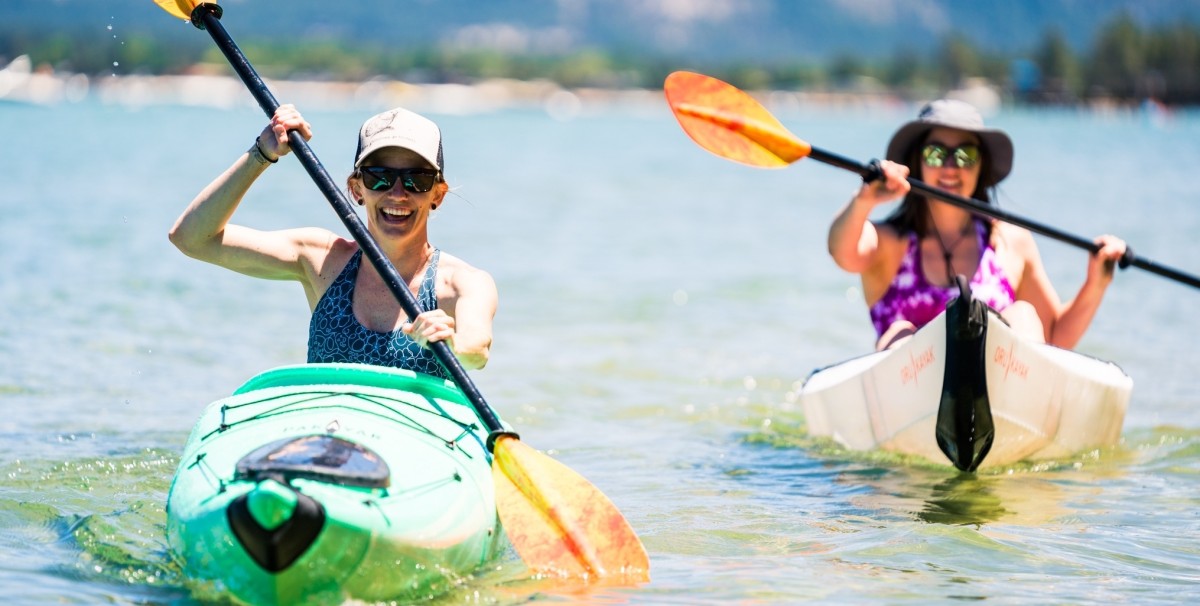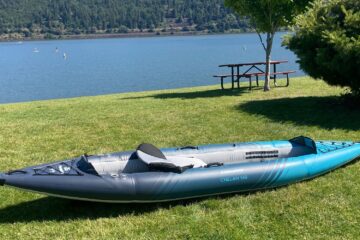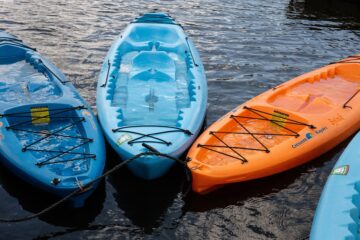Paddling a tandem inflatable kayak requires coordination and communication between partners. The front paddler sets the pace and direction, while the rear paddler provides power and stability. “How to paddle a tandem inflatable kayak” involves proper paddle techniques, weight distribution, and teamwork. To learn more about mastering this exciting water activity, read on.

Choosing the Right Tandem Inflatable Kayak
When you’re ready to share the thrill of kayaking with a friend or family member, picking the best inflatable tandem kayak is crucial. It’s not just about buying any large kayak; it’s about finding the one that fits both your needs and your adventures. Here’s how to choose a Tandem Inflatable Kayak that won’t disappoint.
1. Size and Weight Capacity
- Why it matters: The size of the kayak will determine how comfortably you and your kayaking partner fit. Plus, it must be able to hold both your weights without trouble.
- What to look for: Choose a kayak that’s long enough to give both paddlers ample legroom. Ensure it has a high enough weight capacity to support both paddlers plus any gear you plan to bring along.
2. Material Durability
- Why it matters: Tandem kayaks face more stress because they carry more weight and often tackle more challenging conditions.
- What to look for: Opt for kayaks made from tough, puncture-resistant materials like reinforced PVC. This ensures your kayak can handle the occasional scrape against rocks or branches without getting damaged.
3. Portability and Storage
- Why it matters: Inflatable kayaks need to be easy to transport and store, making them ideal for those with limited space.
- What to look for: Check the kayak’s weight and how compactly it can be folded. Lightweight models that include a carry bag are a plus. Make sure it inflates and deflates quickly for hassle-free setup and take down.
4. Stability and Performance
- Why it matters: A stable kayak is crucial for enjoying your time on the water, especially when paddling with another person.
- What to look for: Wider kayaks tend to be more stable, which is perfect for beginners or if you plan to kayak in calm waters. However, for more speed and maneuverability, look for a slightly narrower design.
5. Extra Features
- Why it matters: Additional features can enhance your kayaking experience by adding convenience and comfort.
- What to look for: Consider kayaks with adjustable seats for better back support, as well as those with extra storage compartments for your belongings. Some kayaks also come with paddles and pumps, which can save you money and time.
By focusing on these aspects, you’ll be sure to find a kayak that brings both fun and comfort to your water adventures.

Preparation and Setup
Setting up your tandem inflatable kayak is the first step to a successful paddling adventure. It’s essential to do this correctly to ensure safety and comfort throughout your journey. Here’s a straightforward guide to get your kayak water-ready without any fuss.
1. Unpack and Unfold
- Start here: Remove the kayak from its storage bag and spread it out on a flat, clean surface to avoid punctures or tears.
2. Inflate
- Pump it up: Using the recommended pump, begin inflating the kayak’s main chambers. Check the manufacturer’s guidelines for the correct pressure levels to avoid over-inflation.
3. Install Seats
- Make it comfortable: Attach the seats securely, adjusting them for the comfort and legroom of both paddlers.
4. Final Checks
- Safety first: Before hitting the water, give your kayak a once-over. Ensure all valves are closed tightly and accessories like fins and rudders are attached correctly.
5. Safety Gear
- Last but not least: Always pack and check your safety gear, including life vests, paddles, and a repair kit, before you leave.
Follow these steps, and your tandem kayak will be set up in no time, leaving you more time to enjoy the water.
Basic Tandem Inflatable Kayak Paddling Techniques
These initial techniques are straightforward but crucial for effective teamwork and efficient movement. Let’s dive into the essentials that will turn you into confident paddlers.
1. Getting In Sync
- Key to coordination: The front paddler sets the rhythm, and the back paddler matches it. This synchronization prevents the paddles from clashing and keeps the kayak moving straight.
2. Forward Stroke
- The main move: Both paddlers should reach forward with their paddles, dipping them into the water and pulling back in a smooth motion. Keep your strokes consistent to maintain speed and direction.
3. Turning the Kayak
- Smooth turns: To turn, the front paddler paddles normally while the back paddler uses a reverse stroke on the opposite side. This coordinated effort allows for sharper turns.
4. Stopping
- Quick stops: Both paddlers should place their paddles flat on the water surface and drag them slightly. This technique is called the “brake stroke” and helps you stop effectively.
5. Communication
- Always talk: Regularly communicate your intentions or any adjustments needed. Clear communication ensures both paddlers are aware and responsive, enhancing the overall experience.
By focusing on these techniques, you and your partner will ensure a safe and enjoyable journey, making every paddle stroke count.
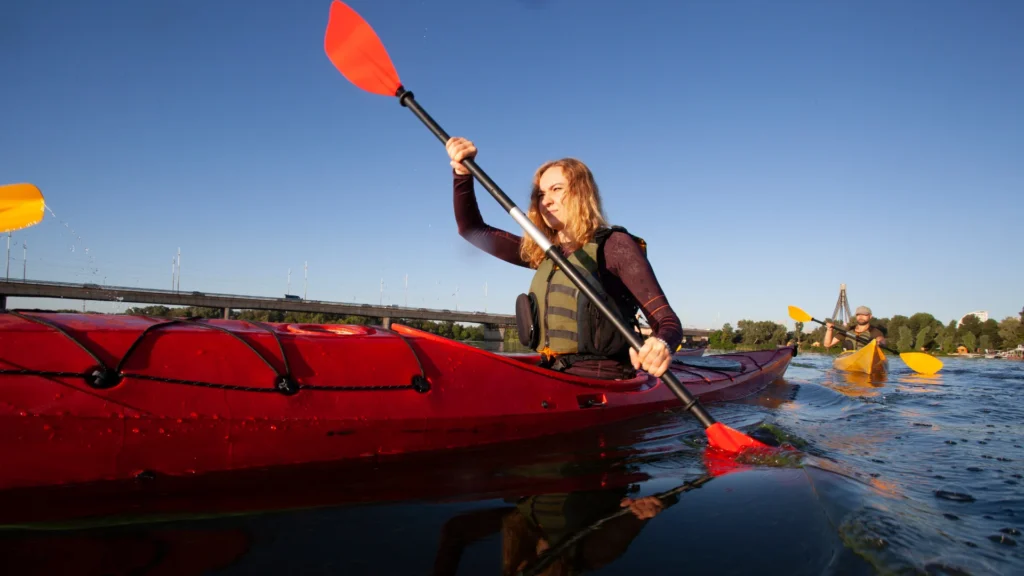
Common Challenges and Solutions With Tips
Here are effective solutions to common challenges you might face. This guide will help you tackle these issues head-on, ensuring a smoother journey.
1. Paddle Clashing
- Problem: Your paddles keep hitting each other.
- Solution: Synchronize your strokes! The front paddler sets the pace, and the rear paddler matches it. Practice on calm waters until you get it right.
2. Difficulty Steering
- Problem: The kayak doesn’t go where you want it to.
- Solution: Communication is key! The rear paddler should steer by using stronger or more frequent strokes on the opposite side of the desired direction. Discuss your route and signals before heading out.
3. Uneven Paddling Strength
- Problem: One paddler is stronger, causing the kayak to veer.
- Solution: The stronger paddler should adjust their strength to match the lighter strokes of the less experienced paddler. This balance will help keep the kayak straight.
4. Managing Fatigue
- Problem: Long trips can get tiring, especially for new paddlers.
- Solution: Take short breaks and switch the front and back positions if possible. This can help distribute the effort evenly and give each paddler a new perspective.
5. Overcoming Fear of Capsizing
- Problem: Worrying about flipping over can make paddlers tense.
- Solution: Practice flipping and re-entering your kayak in a controlled environment. This builds confidence and reduces anxiety.
With these Tips for Paddling a Tandem inflatable Kayak and solutions, you’ll be well-prepared to face common tandem kayaking challenges.
Safety Tips
Safety should always come first when you’re heading out on the water in a tandem kayak. Here’s how to ensure both you and your partner stay safe and can handle any situation confidently.
- Wear Life Jackets: Always wear a properly fitted life jacket, regardless of your swimming skills.
- Check Weather Conditions: Look up the weather before you go. Avoid kayaking in bad weather.
- Carry a Whistle and Light: Keep a whistle for emergencies and a waterproof light if you’re out late.
- Know Your Limits: Stick to water routes that match your skill level. Don’t overestimate your abilities.
- Plan Your Route: Let someone know where you’re going and when you expect to return.
By following these simple yet crucial tips, you can enjoy a fun and safe kayaking adventure with your buddy!
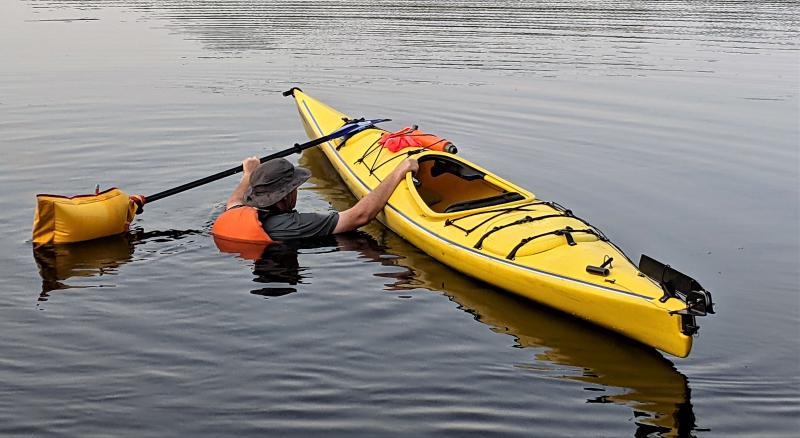
Final Thoughts
Being an expert on how to paddle a tandem inflatable kayak takes practice, communication, and teamwork. By following the techniques, tips, and safety guidelines outlined, you and your partner can confidently embark on thrilling water adventures while enjoying the camaraderie of tandem kayaking.
FAQs
Paddling a tandem inflatable kayak can be more challenging due to the need for coordination and sync between two paddlers.
Yes, if you enjoy shared adventures. They’re great for teamwork, and stability, and can be more economical than two single kayaks.

